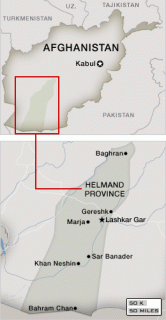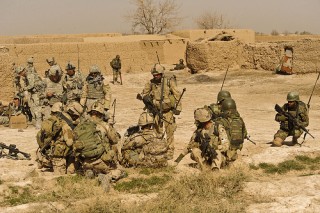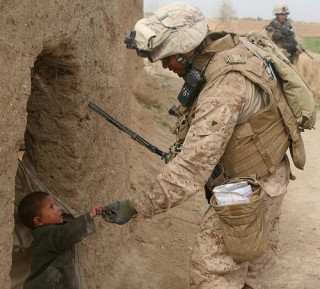 As various Peace groups, including a few Muslim-American organizations, prepare to hit the streets of Washington, DC, Chicago, Illinois, LA and San Francisco, California, an independent investigative reporter has uncovered Pentagon propaganda taken to new heights coming out of progress in Afghanistan.
As various Peace groups, including a few Muslim-American organizations, prepare to hit the streets of Washington, DC, Chicago, Illinois, LA and San Francisco, California, an independent investigative reporter has uncovered Pentagon propaganda taken to new heights coming out of progress in Afghanistan.
He has learned something which should surprise no one outside of mainstream media that is the embellishment of combat reports by U.S. military leaders in Iraq and Afghanistan.
 Propaganda is the dissemination of ideas and information for the purpose of inducing or intensifying specific attitudes and actions. Because propaganda is frequently accompanied by distortions of fact and by appeals to passion and prejudice, it is often thought to be invariably false or misleading. This view is relative, however. Although some propagandists may intentionally distort fact, others may present it as faithfully as objective observers. A lawyer’s brief is as much propaganda as a billboard advertisement. Education, whatever its objective, is a form of propaganda. The essential distinction lies in the intentions of the propagandist to persuade an audience to adopt the attitude or action he or she espouses.”
Propaganda is the dissemination of ideas and information for the purpose of inducing or intensifying specific attitudes and actions. Because propaganda is frequently accompanied by distortions of fact and by appeals to passion and prejudice, it is often thought to be invariably false or misleading. This view is relative, however. Although some propagandists may intentionally distort fact, others may present it as faithfully as objective observers. A lawyer’s brief is as much propaganda as a billboard advertisement. Education, whatever its objective, is a form of propaganda. The essential distinction lies in the intentions of the propagandist to persuade an audience to adopt the attitude or action he or she espouses.”
Robert L. Hanafin, Major, U.S. Air Force-Retired, VT NewsFiction of Marjah as City Was U.S. Information War
 “The Marjah operation is a tactical and operational effort to liberate 75,000 Afghans from Taliban tyranny, the general said. “There was a Taliban flag flying over the place,” Army Gen. Stanley A. McChrystal said. “There was also extensive narco-trafficking and production in the area.”
“The Marjah operation is a tactical and operational effort to liberate 75,000 Afghans from Taliban tyranny, the general said. “There was a Taliban flag flying over the place,” Army Gen. Stanley A. McChrystal said. “There was also extensive narco-trafficking and production in the area.”
According to Gareth Porter and investigative reporter for the international Independent media network Inter Press Services (IPS) News Agency,
“For weeks, the U.S. public followed the biggest offensive of the Afghanistan War against what it was told was a “city of 80,000 people” as well as the logistical hub of the Taliban in that part of Helmand. That idea was a central element in the overall impression built up in February that Marjah was a major strategic objective, more important than other district centres in Helmand.”
It turns out, however, that the picture of Marjah presented by U.S. military officials and obediently reported by major U.S. mainstream news media is one of the clearest and most dramatic pieces of misinformation of the entire war, apparently aimed at hyping the offensive as a historic turning point in the Afghanistan conflict.
 To tell the truth, Marjah is not a city or even a real town, but in reality is a few clusters of farmers’ homes or a large agricultural area covering much of the southern Helmand River Valley.
To tell the truth, Marjah is not a city or even a real town, but in reality is a few clusters of farmers’ homes or a large agricultural area covering much of the southern Helmand River Valley.
The above photo taken a Badula Qulp not far from Marjah gives readers some idea what Marjah really looks like. Marjah is more of a mud hut village of a few thousand people than a town or city 70 to 80,000. Afghan National Security and ISAF troops rest during an early morning dismounted patrol supporting Operation Moshtarak, Feb. 19, 2010. (U.S. Air Force photo by Tech. Sgt. Efren Lopez/Released)
 “It’s not urban at all,” an official of the International Security Assistance Force (ISAF), who asked not to be identified, admitted to IPS Sunday. He called Marjah a “rural community”.
“It’s not urban at all,” an official of the International Security Assistance Force (ISAF), who asked not to be identified, admitted to IPS Sunday. He called Marjah a “rural community”.
“It’s a collection of village farms, with typical family compounds,” said the official, adding that the homes are reasonably prosperous by Afghan standards. The photo above right of a squad leader with the U.S. 6th Marine Regiment giving a piece of candy to an Afghan child while on a patrol in Marjah clearly shows how prosperous by Afghan standards Marjah really is. This is not a city despite reports from the front including the caption with this picture that says, “U.S. Marines and Afghan National Army soldiers patrolled through a residential area of the city to conduct counterinsurgency operations as part of Operation Moshtarak, a push to rid Marjah of Taliban presence and intimidation. (USMC photo by Lance Cpl. Tommy Bellegarde/Released)
Richard B. Scott, who worked in Marjah as an adviser on irrigation for the U.S. Agency for International Development as recently as 2005, agrees that Marjah has nothing that could be mistaken as being urban. It is an “agricultural district” with a “scattered series of farmers’ markets,” Scott told IPS in a telephone interview.
The ISAF official said the only population numbering tens of thousands associated with Marjah is spread across many villages and almost 200 square kilometres, or about 125 square miles. Marjah has never even been incorporated, according to the official, but there are now plans to formalise its status as an actual “district” of Helmand Province. The official admitted that the confusion about Marjah’s population was facilitated by the fact that the name has been used both for the relatively large agricultural area and for a specific location where farmers have gathered for markets. [See the Map above].
However, the name Marjah “was most closely associated” with the more specific location, where there are only a mosque and a few shops. That very limited area was the apparent objective of “Operation Moshtarak”, to which 7,500 U.S., NATO and Afghan troops were committed amid the most intense publicity given any battle since the beginning of the war.
How did the fiction that Marjah is a city of 80,000 people get started?
The idea was passed on to the news media by the U.S. Marines in southern Helmand. The earliest references in news stories to Marjah as a city with a large population have a common origin in a briefing given Feb. 2 by Marine spokesmen at Camp Leatherneck, the U.S. Marine base there.
The Associated Press published an article the same day quoting “Marine commanders” as saying that they expected to be “holed up” in the 400 to 1,000 insurgents“southern Afghan town of 80,000 people.” That language evoked an image of house to house urban street fighting similar to that conducted in major urban areas of Iraq.
The same story said Marjah was “the biggest town under Taliban control” and called it the “linchpin of the militants’ logistical and opium-smuggling network”. It gave the figure of 125,000 for the population living in “the town and surrounding villages”. ABC news followed with a story referring to the “city of Marja” and claiming that the city and the surrounding area “are more heavily populated, urban and dense than other places the Marines have so far been able to clear and hold.”
The rest of the U.S. News Media fell into line:
The rest of the news media fell into line with that image of the bustling, urbanised Marjah in subsequent stories, often using “town” and “city” interchangeably. Time magazine wrote about the “town of 80,000” Feb. 9, and the Washington Post did the same Feb. 11.
A review of media releases coming out of the Pentagon and in-country sources including General McChrystall show the misuse of the terms city or town to give the false impression that Marjah is an urban warfare environment.
Rajiv Chandrasekaran reporting for the Washington Post in his article, Taliban resistance slows coalition forces in Marja, Afghanistan said that “Although U.S. and Afghan forces have made steady inroads here [Marja] since beginning the largest joint military operation of the war…, they control only a few modest patches of this farming community, principally around the two biggest bazaar areas. Much of Marja has not yet been patrolled by troops on the ground, and video images from surveillance drones have shown Taliban fighters operating with impunity in those places. U.S. and NATO commanders were not certain whether the insurgents who have lorded over Marjah for the past three years would stay and fight, or flee to parts of Afghanistan with fewer international security forces. It appears clear, however, that many Taliban members here have opted to stay — at least for now. That may mean many more weeks of arduous house-to-house clearing operations for Marines and Afghan forces in this 155-square-mile area, making this a far more complex and dangerous mission than initially envisaged, and possibly delaying some efforts to deliver government services and reconstruction projects to the 80,000 people who live here.”
“It’s early days yet,” said British Maj. Gen. Nick Carter, the top allied commander in southern Afghanistan. “You’re dealing with a large area, with a lot of people in it. It’s going to take a while to clear it.”
As “Operation Moshtarak” began, U.S. military spokesmen were portraying Marjah as an urbanised population centre. On Feb. 14, on the second day of the offensive, Marine spokesman Lt. Josh Diddams said the Marines were “in the majority of the city at this point.” He also used language that conjured images of urban fighting, referring to the insurgents holding some “neighbourhoods”.
Several media networks did report or quote Lt. Diddams as saying, “”We’re in the majority of the city at this point,” said Lt. Josh Diddams, a Marine spokesman. He said the nature of the resistance has changed from the initial assault, with insurgents now holding ground in some neighborhoods. We’re starting to come across areas where the insurgents have actually taken up defensive positions,” he said. “Initially it was more hit and run.”
CBS News:
General: Maybe Weeks to Reclaim Marjah – Pockets of Militants Fight Marines, Afghan Troops in Second Day of Offensive at Taliban Stronghold
A few days into the offensive, some reporters began to refer to a “region”, but only created confusion rather than clearing the matter up. CNN managed to refer to Marja twice as a “region” and once as “the city” in the same Feb. 15 article, without any explanation for the apparent contradiction.
The Associated Press further confused the issue in a Feb. 21 story, referring to “three markets in town – which covers 80 square miles….”
A “town” with an area of 80 square miles would be bigger than such U.S. cities as Washington, D.C., Pittsburgh and Cleveland. But AP failed to notice that something was seriously wrong with that reference.
Washington, DC is approximately 68.3 sq mi with a population of 599,657 vs. mainstream media and Pentagon claims that the ‘city’ of Marjah is 80 square miles with a population of 80,000.
Long after other media had stopped characterizing Marja as a city, the New York Times was still referring to Marja as “a city of 80,000”, in a Feb. 26 dispatch with a Marjah dateline.
Why did mainstream media assist the Pentagon in hyping up Marjah?
Just as mainstream U.S. media played an essential propaganda role in building up public support for the Invasion of Iraq, the decision to hype up Marjah as the objective of “Operation Moshtarak” by planting the false impression that it is a good-sized city would not have been made independently by the lower level Marine command structure at Camp Leatherneck.
A central task of “information operations” in counterinsurgency wars is “establishing the COIN [counterinsurgency] narrative”, according to the Army Counterinsurgency Field Manual as revised under Gen. David Petraeus in 2006. That task to use misinformation is usually done by “higher headquarters” rather than in the field, as the manual notes.
The COIN manual asserts that mainstream U.S. news media “directly influence the attitude of key audiences toward counterinsurgents, their operations and the opposing insurgency.” The manual refers to well INFOWARS – “a war of perceptions…conducted continuously using the news media.”
Frankly, COIN narrative is a polite way of saying PROPAGANDA, so that it can be used by mainstream media to call it JOURNALISM in order to hype up or SELL War.
Gen. Stanley A. McChrystal, commander of ISAF, was clearly preparing to wage such an INFO 0r PROPAGANDA war against the American public in advance of the Marjah operation. In remarks made just before the offensive began, McChrystal invoked the language of the counterinsurgency manual, saying, “This is all a war of perceptions.”
The Washington Post admitted on Feb. 22 that the decision to launch the offensive against Marjah was intended largely to impress U.S. public opinion with the effectiveness of the U.S. military in Afghanistan by showing that it could achieve a “large and loud victory” over what in reality was a small village in the middle of nowhere Afghanistan. This is also a case of both the Pentagon and mainstream media playing upon the basic geographic and cultural ignorance and arrogance of the American public. Put politely mainstream U.S. media and the Pentagon believes WE THE PEOPLE are really as dumb as we act.
The false impression that Marjah was a significant city was an essential part of that PROPAGANDA message.
“The military part of the operation in the region is not over, but the high-profile part of security operations is, the general said. Following the strategy of “clear, hold, build and transfer,” the clear portion of the operation will continue for months, he said. “But we have essentially gotten control of the area now, and we have begun moving into the next phase – the hold and build,” McChrystal said.
“Establishing effective government control in the region is key to success as the operation continues,” McChrystal said. “The governmental part of the operation concentrates on the people and allows the national government to show its leadership in a critical area. It also telegraphs where the military and government will move next.”
“Many people talk about Kandahar,” McChrystal said. “We are absolutely going to secure Kandahar. We are already doing a lot of operations in Kandahar, but it is our intent under [Afghan] President [Hamid] Karzai’s direction to make an even greater effort there.”
Related story:
Operation Moshtarak: Gen. McChrystal Details Lessons of Marja Offensive
http://www.isaf.nato.int/en/article/news/gen.-mcchrystal-details-lessons-of-marja-offensive.html
About the Author
 Gareth Porter is an independent historian and star investigative journalist for IPS. He is known for the scholarly rigor of his research and analysis and for the frequent scoops which have undermined official propaganda.
Gareth Porter is an independent historian and star investigative journalist for IPS. He is known for the scholarly rigor of his research and analysis and for the frequent scoops which have undermined official propaganda.
Porter follow’s Amira Hass’s famous dictum about journalism in constantly monitoring the centers of power. He has been driving a truck through the carefully constructed edifice of lies and deception of successive administration’s as often as they have been erected.
In 2009 alone he has produced several in-depth reports casting doubt over the Bush administration’s rationale for war in Iraq, the Taliban-al Qa’ida connection, and the alleged Iranian experiments with a ‘neutron initaitor’ for an atomic bomb.
He is one of the few investigative journalist specialising in U.S. national security policy. The paperback edition of his latest book, “Perils of Dominance: Imbalance of Power and the Road to War in Vietnam”, was published in 2006.
Readers are more than welcome to use the articles I’ve posted on Veterans Today, I’ve had to take a break from VT as Veterans Issues and Peace Activism Editor and staff writer due to personal medical reasons in our military family that take away too much time needed to properly express future stories or respond to readers in a timely manner.
My association with VT since its founding in 2004 has been a very rewarding experience for me.
Retired from both the Air Force and Civil Service. Went in the regular Army at 17 during Vietnam (1968), stayed in the Army Reserve to complete my eight year commitment in 1976. Served in Air Defense Artillery, and a Mechanized Infantry Division (4MID) at Fort Carson, Co. Used the GI Bill to go to college, worked full time at the VA, and non-scholarship Air Force 2-Year ROTC program for prior service military. Commissioned in the Air Force in 1977. Served as a Military Intelligence Officer from 1977 to 1994. Upon retirement I entered retail drugstore management training with Safeway Drugs Stores in California. Retail Sales Management was not my cup of tea, so I applied my former U.S. Civil Service status with the VA to get my foot in the door at the Justice Department, and later Department of the Navy retiring with disability from the Civil Service in 2000.
I’ve been with Veterans Today since the site originated. I’m now on the Editorial Board. I was also on the Editorial Board of Our Troops News Ladder another progressive leaning Veterans and Military Family news clearing house.
I remain married for over 45 years. I am both a Vietnam Era and Gulf War Veteran. I served on Okinawa and Fort Carson, Colorado during Vietnam and in the Office of the Air Force Inspector General at Norton AFB, CA during Desert Storm. I retired from the Air Force in 1994 having worked on the Air Staff and Defense Intelligence Agency at the Pentagon.
ATTENTION READERS
We See The World From All Sides and Want YOU To Be Fully InformedIn fact, intentional disinformation is a disgraceful scourge in media today. So to assuage any possible errant incorrect information posted herein, we strongly encourage you to seek corroboration from other non-VT sources before forming an educated opinion.
About VT - Policies & Disclosures - Comment Policy



